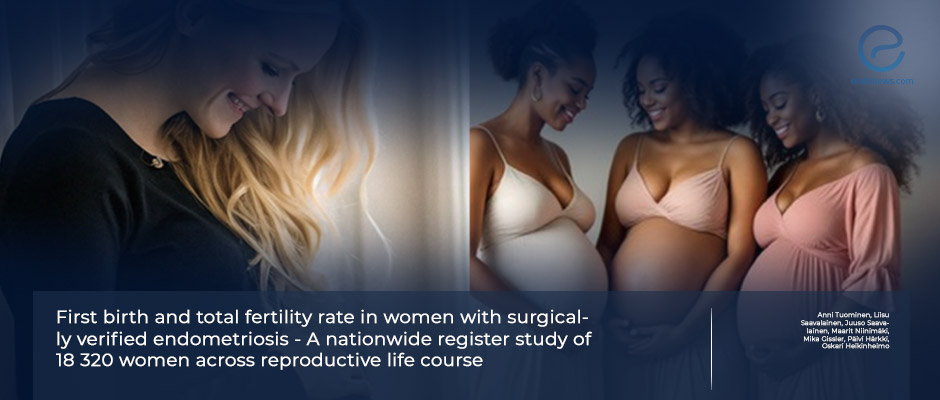Endometriosis Subtypes and Total Fertility Rate: A Nationwide Study
Jul 17, 2025
Endometrios May Impact Timing and Number of Births
Key Points
Importance:
- Women with surgically confirmed endometriosis have a significantly lower total fertility rate across their reproductive years compared to women without the disease.
Highlights:
- Infertility was nearly 4 times more prevalent, and assisted reproductive technology (ART) use was 5 times higher in women with endometriosis versus controls.
- Women with ovarian endometriosis had a particularly lower first birth rate compared to those with peritoneal or deep endometriosis.
- No statistically significant difference in total fertility rates was observed across endometriosis subtypes.
What's done here:
- This large-scale, nationwide Finnish study assessed first birth rate and total fertility rate in women with surgically verified endometriosis versus population controls.
- Data from Finnish national health registries (1987–2012) were analyzed in a retrospective, controlled cohort design.
- Follow-up began at age 15 and continued until the first live birth or end of reproductive age.
Key Results:
- The study included 18,320 women with endometriosis and 35,788 controls.
- Endometriosis subtypes were categorized as: peritoneal (5,786), ovarian (6,519), deep (1,267), and combined (4,748).
- The total fertility rate was 1.33 in the endometriosis cohort versus 1.89 in controls.
- Women with endometriosis had a longer time to first birth (restricted mean survival time) across all subtypes.
- Ovarian endometriosis was associated with the lowest birth rate, while peritoneal and deep endometriosis showed relatively higher rates.
- Overall, women with endometriosis had a 10% lower fertility rate compared to the general population.
From the Editor-in-Chief – EndoNews
"Endometriosis continues to challenge fertility outcomes, with ovarian disease showing the greatest impact—early, tailored interventions are key.
This nationwide Finnish study highlights a clear reduction in fertility among women with endometriosis, with ovarian disease showing the lowest first birth rates. Despite decades of medical advances, the gap in reproductive outcomes persists, underscoring the need for early diagnosis and personalized fertility care. These findings call for renewed focus on how surgical and medical strategies can optimize long-term reproductive health in this population."
Lay Summary
The link between endometriosis and infertility has long been recognized, but large-scale studies comparing fertility outcomes across different subtypes of endometriosis remain limited.
Researchers have also sought to understand how surgical treatment affects the likelihood of achieving a live birth.
In a nationwide Finnish study, the team led by Dr.Heikinheimo from Helsinki University Hospital analyzed the first birth rate and total fertility rate in women with surgically verified endometriosis, compared to women without the condition.
Using data from the Finnish Care Register for Health Care (CRFHC) spanning 1987–2012, the study included over 18,000 women with endometriosis and nearly 36,000 controls. Patients were followed from age 15 until their first live birth, or until hysterectomy, bilateral oophorectomy, or the end of the study period.
The findings showed that women with endometriosis had a higher rate of infertility and were five times more likely to use assisted reproductive technologies (ART) such as IVF/ICSI compared to controls.
The total fertility rate was significantly lower in all subtypes of endometriosis, with ovarian endometriosis showing the lowest first birth rate. However, no statistically significant difference in fertility rates was observed between the different endometriosis subtypes. Endometriosis subtypes were represented as peritoneal (5,786), ovarian (6,519), deep (1,267), and combined (4,748) in current series.
Importantly, the authors emphasized that their analysis covered decades of clinical practice, during which diagnostic methods, surgical techniques, and infertility treatments evolved considerably.
This comprehensive study underscores the long-term reproductive challenges faced by women with endometriosis and highlights the need for early diagnosis and tailored fertility care.
The study was published in Acta Obstetricia et Gynecologica Scandinavica.
Research Source: https://pubmed.ncbi.nlm.nih.gov/40538001/
birth rate total fertility rate invitro fertilization deep endometriosis adenomyosis ART sterilization bilateral oopherectomy hysterectomy endometriosis.

